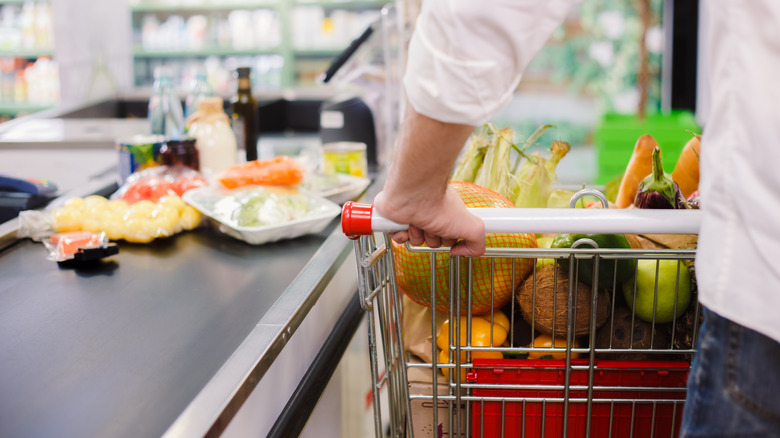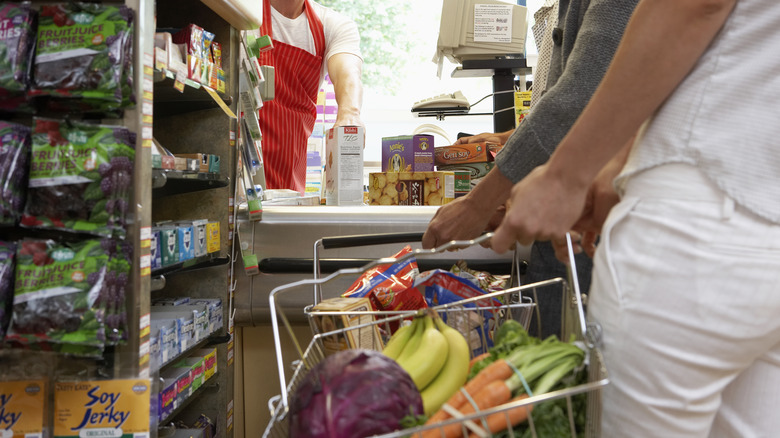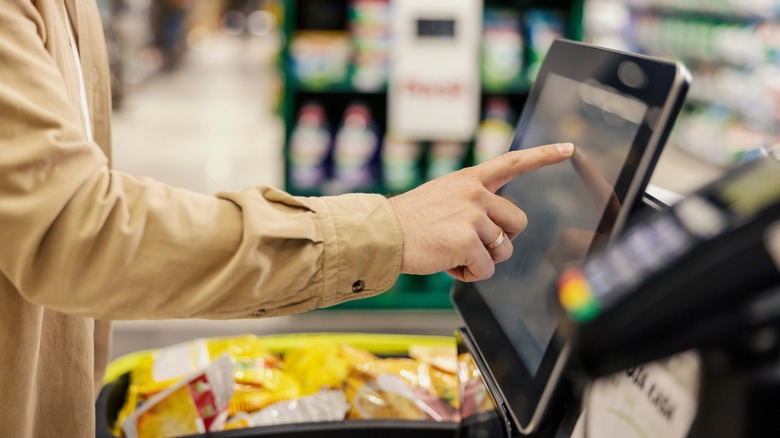Why It's A Mistake To Choose Express Grocery Checkout Every Time
Most people want to spend less time at the grocery store, not more. The grab-it-and-go mantra has run through all our heads when in a rush — especially during peak shopping hours. The urge to get in and out in record time is one reason to leave home with a list or a photo of what's in your fridge. Figure out exactly what you need and find it. But if the store is crowded, you might be brought to a grinding halt when it's time to pay. One final make-or-break decision stands between you and the parking lot: Which grocery checkout line should you choose?
There are many methods to making it through this final frenzy in a timely fashion. You might look for a lane with more baskets than two-tier carts or opt for the checkout where the cashier is already handing a receipt to someone. If you're not at the supermarket alone, you might even game the system with your partner-in-shopping, each choosing a line to hedge your bets. Most likely, though, if you're only buying a few things, you make a beeline to the express checkout lane — but that might be a mistake.
While express grocery checkout restricts the number of items each customer can have, whether less than 15 or 20, that rule doesn't guarantee the line will be faster. Instead, slowdowns at supermarket checkouts have more to do with the number of people ahead of you than how many items each person is purchasing.
Longer checkout lines cause longer waits than having lots of items
If you're in a rush at the grocery store, there's no more dreadful sight than the person in front of you pulling out a checkbook to pay. You might try to anticipate who will take a while, but people are unpredictable. Even if you're observant, it's impossible to know for sure who will pull out a stack of coupons, want to make small talk, or need their ID checked. Termed "tender time," each customer's actions tack on extra seconds to the checkout process. And those seconds add up. So when it comes to assessing grocery checkout lanes, it's worth considering the sure thing: How long it'll take the cashier to ring up each item.
Turns out, scanning takes a lot less time than people paying. In 2009, math teacher and blogger Dan Meyer set out to determine how to pick the fastest checkout line. He went to the store to study, not shop, timing the grocery-purchasing process. Drawing on checkout scanner data, Meyer discovered that for every person in line, an additional 48 seconds is added to your wait. An extra item, on the other hand, only adds an extra 2.8 seconds. When he compared the two on his blog, Meyer concluded that it's better to choose a line with 17 more items rather than an extra person. Since express grocery checkout is designed to accommodate more people and fewer items, it's not actually very efficient after all.
So, what grocery checkout lane is the fastest?
Even knowing the math, it's not worth the hassle of trying to count every person's items in line. After all, if you're in a rush, adding up the wait time of each checkout lane probably won't save you any. At that point, you might be better off choosing one at random. To shorten your trip to the grocery store, simply follow the general principle that a lane with more items than people is the best bet — one backed by math, not vibes.
Of course, if the same number of people are standing in regular checkout lines as those for express checkout, it's logical to choose the express lane. At the very least, you know the tender time should be about the same, while there are fewer items to scan. But if the standard lanes aren't quite as crowded, wait behind a couple of people with carts rather than a group of people with baskets.
Another alternative to express checkout, self-checkout lanes can also be helpful when you're in a hurry, especially if there are tons of tills. If someone is efficient at scanning their items — perhaps a big if, since it partly depends on people following self-checkout etiquette rules – you can save time avoiding the typical slowdowns that increase tender time.
Just remember: If you're in a rush, it's always best to take the lane less traveled by – not necessarily express checkout. It will make all the difference.


